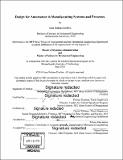Design for automation in manufacturing systems and processes
Author(s)
Ezolino, Juan Stefano
DownloadFull printable version (5.415Mb)
Other Contributors
Leaders for Global Operations Program.
Advisor
Thomas Roemer and Daniel Whitney.
Terms of use
Metadata
Show full item recordAbstract
The Widget' industry has changed significantly over the last 20 years. Although Company A benefited from their historically strong market position for a long time, the market share of widgets has, at this point, been evenly divided between Company A and Company B. There is therefore market pressure for Company A to reassess the way it does business to be more competitive. Automation initiatives in the Widget industry have historically been slow to be implemented, and there has been hesitation to change the way widgets and their parts are designed and manufactured due to the complexity of the widget product. But in order to work in a more competitive global market, companies must question many of the established assumptions regarding their products in order to achieve efficiency gains and improve safety standards in their production system. The ultimate goal of the project was to align the design, manufacturing, and business processes with new technology capabilities and the goals of the company. By doing this, the cost of producing a widget would be decreased, while increasing in-process quality and repeatability. This thesis focuses on ways in which to show the value of improving the design of a widget to enable more efficient production systems, while ensuring the risk of injury to the mechanics is continuously lowered through increased process control and standardization. In order to understand what it means for engineers across the company to design parts and assemblies with automated manufacturing processes in mind, a list of high-level technical design principles needed to be developed. A group of 17 design and production engineers was assembled for a workshop, representing all of the widget programs, R&D, Product Development, Fabrication, Engineering Operations, Manufacturing Operations, and IT. Through two days of activities, a list of ten principles was developed that could be applied to any widget part or assembly that was intended to be manufactured through automation. After the Design for Automation (DfA) principles were established and agreed-upon, it was necessary to find ways to effectively implement new tools and methodologies into the established design process.
Description
Thesis: M.B.A., Massachusetts Institute of Technology, Sloan School of Management, 2016. In conjunction with the Leaders for Global Operations Program at MIT. Thesis: S.M. in Engineering Systems, Massachusetts Institute of Technology, Department of Mechanical Engineering, 2016. In conjunction with the Leaders for Global Operations Program at MIT. Cataloged from PDF version of thesis. Includes bibliographical references (pages 88-89).
Date issued
2016Department
Leaders for Global Operations Program at MIT; Massachusetts Institute of Technology. Department of Mechanical Engineering; Sloan School of ManagementPublisher
Massachusetts Institute of Technology
Keywords
Sloan School of Management., Mechanical Engineering., Leaders for Global Operations Program.